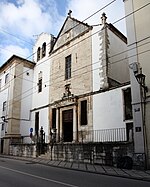Choupal National Forest

Choupal National Forest (Portuguese: Mata Nacional do Choupal) is a national forest in Coimbra, Portugal. It is a short distance from the city downtown and runs alongside the Mondego River. The forest has trails for jogging, walking, cycling and horse-riding.This grove of poplar trees (choupos, whence choupal "poplar grove"), was planted in an attempt to stop the floods of the Mondego river. In 1791, the engineer and Padre (Father, priest) Estêvão Cabral directed a big project that was meant to decrease the levels of silt in the river. The trees of Choupal were therefore planted to allow a better settling of the riverbed. Since the 19th century many other trees, including planes (sycamores; Platanus orientalis), beeches, laurels, and eucalyptus have grown in the area. Today the forest is a popular place for recreation, exercise and picnics.
Excerpt from the Wikipedia article Choupal National Forest (License: CC BY-SA 3.0, Authors, Images).Choupal National Forest
Estrada do Choupal, Coimbra Bencanta (Coimbra (Sé Nova, Santa Cruz, Almedina e São Bartolomeu))
Geographical coordinates (GPS) Address Nearby Places Show on map
Geographical coordinates (GPS)
| Latitude | Longitude |
|---|---|
| N 40.221944444444 ° | E -8.4461111111111 ° |
Address
Clube de Ténis do Choupal
Estrada do Choupal
3000-477 Coimbra, Bencanta (Coimbra (Sé Nova, Santa Cruz, Almedina e São Bartolomeu))
Portugal
Open on Google Maps








